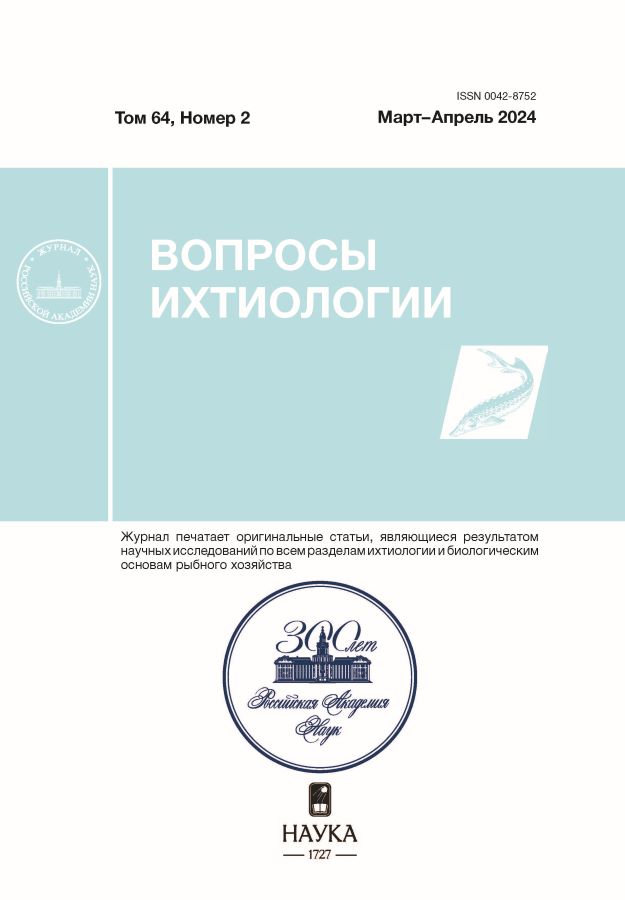Тактики поведения рыб в потоке воды при голодании
- Авторлар: Павлов Д.С.1, Паршина В.Ю.1, Костин В.В.1
-
Мекемелер:
- Институт проблем экологии и эволюции РАН
- Шығарылым: Том 64, № 2 (2024)
- Беттер: 230-235
- Бөлім: Articles
- URL: https://medjrf.com/0042-8752/article/view/650320
- DOI: https://doi.org/10.31857/S0042875224020072
- EDN: https://elibrary.ru/GWRSFK
- ID: 650320
Дәйексөз келтіру
Аннотация
В экспериментальной кольцевой гидродинамической установке определены индивидуальные параметры перемещения у данио Danio rerio и серебряного карася Carassius gibelio при их голодании в течение 12 сут. Выявлены две тактики поведенческих ответов рыб на голодание. Тактика однонаправленных ответов проявлялась в движении особей в одном направлении относительно течения на 2–5-е сут голодания. Тактика разнонаправленных ответов проявлялась в образовании на 10–12-е сут голодания групп рыб, перемещающихся в разных направлениях относительно течения. Рассмотрены популяционные преимущества таких поведенческих тактик ответа рыб на неблагоприятный фактор.
Негізгі сөздер
Толық мәтін
Авторлар туралы
Д. Павлов
Институт проблем экологии и эволюции РАН
Хат алмасуға жауапты Автор.
Email: povedenie@yandex.ru
Ресей, Москва
В. Паршина
Институт проблем экологии и эволюции РАН
Email: povedenie@yandex.ru
Ресей, Москва
В. Костин
Институт проблем экологии и эволюции РАН
Email: povedenie@yandex.ru
Ресей, Москва
Әдебиет тізімі
- Гурский Е. И. 1971. Теория вероятностей с элементами математической статистики. М.: Высш. шк., 328 с.
- Звездин А. О. 2016. Реореакция ранней молоди нерки Oncorhynchus nerka (Walb.) в период расселения с нерестилищ: Автореф. дис. … канд. биол. наук. М.: ИПЭЭ РАН, 28 с.
- Павлов Д.С. 1979. Биологические основы управления поведением рыб в потоке воды. М.: Наука, 319 с.
- Павлов Д. С., Савваитова К. А. 2008. К проблеме соотношения анадромии и резидентности у лососевых рыб (Salmonidae) // Вопр. ихтиологии. Т. 48. № 6. С. 810–824.
- Павлов Д. С., Костин В. В., Звездин А. О. и др. 2019. Реореакция молоди некоторых карповых рыб (Cyprinidae) в период осенней контранатантной миграции // Там же. Т. 59. № 6. С. 716–723. https://doi.org/10.1134/S0042875219060122
- Павлов Д. С., Костин В. В., Павлов Е. Д., Кравченко А. А. 2020а. Влияние изменения рациона на реореакцию молоди радужной форели Oncorhynchus mykiss // Там же. Т. 60. № 3. С. 364–367. https://doi.org/10.31857/S0042875220030157
- Павлов Д. С., Паршина В. Ю., Костин В. В., Прозоров Д. А. 2020б. Сравнение экспериментальных методов оценки мотивационной компоненты реореакции рыб (соотношения типов реореакции) // Там же. Т. 60. № 4. С. 478–487. https://doi.org/10.31857/S0042875220040189
- Павлов Д. С., Костин В. В., Паршина В. Ю., Павлов Е. Д. 2021. Изменение соотношения типов реореакции у рыб при голодании // Изв. РАН. Сер. биол. № 5. С. 521–527. https://doi.org/10.31857/S1026347021040119
- Печеровый А. В. 2005. К вопросу определения площадей неразделенных пиков в автоматизированных системах обработки хроматограмм // Исследовано в России. Т. 8. С. 366–373.
- Borovkov M., Savyolova T. 2007. The computational approaches to calculate normal distributions on the rotation group // J. Appl. Cryst. V. 40. № 3. P. 449–455. https://doi.org/10.1107/S0021889807005626
- Chapman B. B., Brönmark C., Nilsson J-Å., Hansson L-A. 2011. The ecology and evolution of partial migration // Oikos. V. 120. № 12. P. 1764–1775. https://doi.org/10.1111/j.1600–0706.2011.20131.x
- Chapman B. B., Hulthén K., Brodersen J. et al. 2012. Partial migration in fishes: causes and consequences // J. Fish Biol. V. 81. № 2. P. 456–478. https://doi.org/10.1111/j.1095–8649.2012.03342.x
- Dodson J. J., Aubin-Horth N., Thériault V., Páez D. J. 2013. The evolutionary ecology of alternative migratory tactics in salmonid fishes // Biol. Rev. V. 88. № 3. P. 602–625. https://doi.org/10.1111/brv.12019
- Falconer D.S, Mackay T. F.C. 1996. Introduction to quantitative genetics. Harlow: Pearson Education, 459 p.
- Ferguson A., Reed T. E., Cross T. F. et al. 2019. Anadromy, potamodromy and residency in brown trout Salmo trutta: the role of genes and the environment // J. Fish Biol. V. 95. № 3. P. 692–718. https://doi.org/10.1111/jfb.14005
- Flecker A. S., McIntyre P.B., Moore J. W. et al. 2010. Migratory fishes as material and process subsidies in riverine ecosystems // Am. Fish. Soc. Symp. V. 73. P. 559–592. https://doi.org/10.47886/9781934874141.ch28
- Hutchings J. A. 1986. Lakeward migration by juvenile Atlantic salmon, Salmo salar // Can. J. Fish. Aquat. Sci. V. 43. № 4. P. 732–741. https://doi.org/10.1139/f86–090
- Jonsson B., Jonsson N. 1993. Partial migration: niche shift versus sexual maturation in fishes // Rev. Fish Biol. Fish. V. 3. № 4. P. 348–365. https://doi.org/10.1007/BF00043384
- Johnston M. E., Kelly J. T., Lindvall M. E. et al. 2017. Experimental evaluation of the use of vision and barbels as references for rheotaxis in green sturgeon // J. Exp. Mar. Biol. Ecol. V. 496. P. 9–15. https://doi.org/10.1016/j.jembe.2017.04.002
- MacLean J.A., Gee J. H. 1971. Effect of temperature on movements of pre-spawning brook sticklebacks, Culaea inconstans, in the Roseau River, Manitoba // J. Fish. Res. Board Can. V. 28. № 6. P. 919–923. https://doi.org/10.1139/f71–133
- Olsson I. C., Greenberg L. A., Bergman E., Wysujack K. 2006. Environmentally induced migration: the importance of food // Ecol. Lett. V. 9. № 6. P. 645–651. https://doi.org/10.1111/j.1461–0248.2006.00909.x
- Pavlov D. S., Kostin V. V., Zvezdin A. O., Ponomareva V. Yu. 2010. On methods of determination of the rheoreaction type in fish // J. Ichthyol. V. 50. № 11. P. 977–984. https://doi.org/10.1134/s0032945210110020
- Shaw A. K., Levin S. A. 2011. To breed or not to breed: a model of partial migration // Oikos. V. 120. № 12. P. 1871–1879. https://doi.org/10.1111/j.1600–0706.2011.19443.x
Қосымша файлдар













